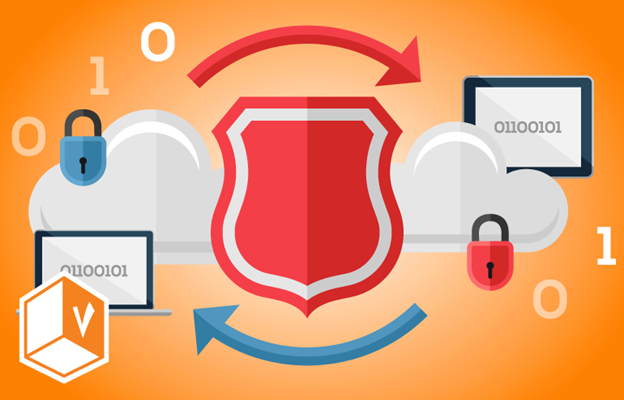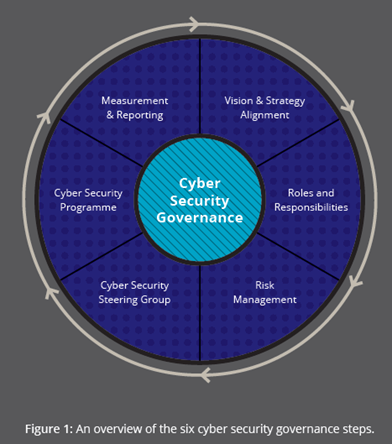Every organisation’s journey toward cyber resilience will be different. Navigating the individual complexities of governance requires leaders to chart their organisation’s own course. The terms cyber resilience and cyber security are both used in Charting Your Course. Cyber resilience is suggested as a realistic goal for an organisation; rather than focusing primarily on prevention of cyber incidents, resilience also emphasises the importance of recovery and response.
Cyber security is primarily used to describe the discipline or practice of protecting the confidentiality, integrity and availability of information assets and systems.

Why have Cyber Security Governance?
Clearly defined cyber security governance allows organisations to maximise the benefits of operating in a digital economy. Effective cyber security governance supports the success and sustainability of digital business transformation. Without good cyber security governance, organisations will find it increasingly difficult to ensure basic business continuity or maintain the confidence of external stakeholders.
The outcomes of effective cyber security governance are:
- A cyber security vision that guides the decision-making process across the entire organisation, in line with the overall strategy.
- Well-defined and assigned cyber security roles and responsibilities that are integrated within the organisation.
- A holistic approach to risk management that incorporates cyber security risk, and an improved understanding of the cyber threats faced by the organisation.
- Oversight and allocation of resources through a cyber security forum and cyber security program.
- A robust system for measuring and reporting compliance and continuous improvement.
Accountability for cyber security sits at the top of an organisation because cyber security outcomes affect the entire business. The board is also best positioned to manage competing risks and align cyber security with other business activities. The board should monitor the investment in—and impact of—cyber security activities, enabled by metrics and reporting provided to them.

Below the board level, executive management guides the organisation’s policies and strategies. Nominated security leaders then take responsibility for the delivery of a cyber security program and the development of controls. The implementation of controls is managed by internal teams along with external specialist support.
A steering committee can include representatives from each organisational layer, and this is often the best method for an organisation to collectively deliver the cyber security program.
STEP 1 - Building a Culture of Cyber Security
A positive cyber security culture of awareness and accountability is driven by the board. The existing culture should be recognised but influenced by a demonstrated commitment to achieving cyber resilience. The development of a cyber security strategy can promote cultural change, showing the relationship between the organisation’s vision and cyber security. A positive cyber security culture also includes supporting everyone in the organisation to play their part in protecting the confidentiality, integrity and availability of the organisation’s information assets and systems.

STEP 2 - Establishing Roles and Responsibilities
Achieving effective cyber security governance requires defining and establishing the organisation’s cyber security roles and responsibilities. After they are created, consider at what level in the organisation they need to be performed. In smaller organisations, most cyber security functions may fall to a single person. In such cases, it is even more important for senior leaders to ensure cyber security duties are realistic, clearly understood, and well communicated. Everyone in the organisation should understand their role in supporting effective cyber security.
STEP 3 - Holistic Risk Management
Effective risk management is a core component of governance and must be embedded within the organisation. A framework is needed to effectively identify, analyse, evaluate, and manage cyber security risks. The framework supports consistent decision-making and prioritisation within an organisation, maximising the benefit of investment in cyber security. If an existing risk framework or methodology exists, cyber security should be aligned to this framework.
STEP 4 - Cyber Security Collaboration
Translating a cyber security strategy and vision into action requires the buy-in and support of the wider organisation. This can be achieved by establishing a committee containing key stakeholders from across the business. The main objective of the steering committee is to achieve consensus and align cyber security priorities with the organisation’s objectives. Steering committees are most effective when they contain representatives who can make decisions on resource allocation, prioritisation, and direct cyber security activities.
STEP 5 - Create a Cyber Security Programme
Organisations should establish a measurable cyber security programme. The programme translates the strategy into action, driving initiatives and continuous improvements in cyber resilience. The steering committee oversees the cyber security programme.
STEP 6 - Measuring Resilience
The effectiveness of cyber security activities should be accurately measured, assessed and reported. These actions indicate the current cyber resilience of an organisation and progress made through the cyber security programme. Measurement and reporting are vital to good governance, enabling informed decision-making and sustainable investment in cyber security.

Signing up for Tri-Paragon’s AgileBlue Security Operations Centre as a Service goes a long way to cyber securing your business. Tri-Paragon’s AgileBlue SOCaaS is a combination of autonomous SOC technology and cybersecurity experts. WE ARE YOUR PROXY CYBER TEAM. We developed our technology on top of the ELK Stack (Elastic, Logstash and Kibana) to be the foundation of our modern machine learning and correlation engine. Our dedicated Security Operations Center team services our clients in a global footprint.
See how Tri-Paragon’s AgileBlue Machine Learning + User Behavior Analytics SOC-as-a-Service can keep you safe from a breach. https://agileblue.com/
For additional information on our AgileBlue Security Operations Centre as a Service and to arrange a demo call Roy at 1 (416) 865-3392 or email us at info@triparagon.com .
https://www.triparagon.com/






